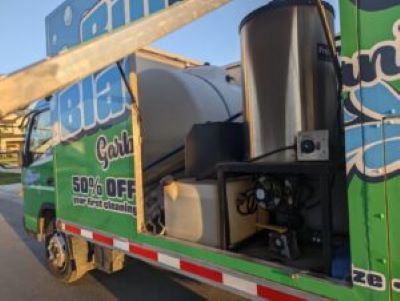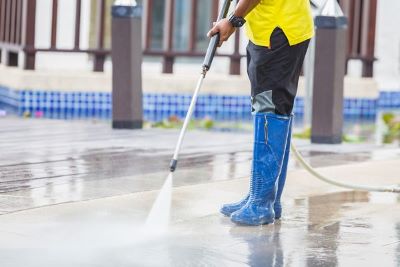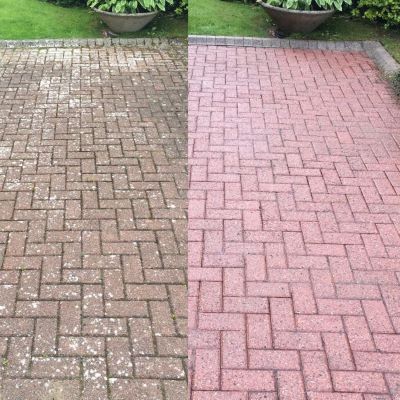Thinking about starting a pressure washing business? Here’s A Complete Guide to Pressure Washing to help you get it right from day one.
Article Summary
- Select the right pressure washer and accessories based on the types of jobs you plan to tackle.
- Master fundamental pressure washing techniques, including surface preparation and proper nozzle use, to ensure quality results and prevent damage.
- Expand your service offerings beyond basic pressure washing by leveraging versatile equipment, like the Bin Blasters starter trailer with its included pressure washing line.
- Develop a solid marketing plan to attract local customers and build a base of recurring clients for steady income.
- Prioritize safety by using appropriate gear and following best practices when operating pressure washing equipment.
Let’s Talk About Starting Your Pressure Washing Business
Hey folks, Casey Evertsen here! So, you’re thinking about diving into the world of pressure washing? Awesome! It’s a fantastic way to be your own boss, work outdoors (sometimes even in flip-flops, like me!), and build something you can be proud of. I started Bin Blasters cleaning garbage cans, and let me tell ya, adding pressure washing services can really boost your business. But like anything worth doing, you gotta start smart.
I’ve seen too many eager entrepreneurs jump in, spend a fortune on fancy gear, and then fizzle out because they didn’t have a plan. Don’t let that be you! We’re gonna break down how to get started the right way, avoiding those early pitfalls I definitely stumbled into myself. It’s about more than just blasting water; it’s about building a real, sustainable business.
Choose the right equipment setup
First things first, you need the tools for the trade. But hold on – don’t just buy the biggest, baddest machine you see. Think about the jobs you’ll realistically be doing starting out. Residential driveways? Decks? Siding? Each requires slightly different considerations. We’ll get more into the specifics later, but the key is matching the equipment to the work. Starting with a versatile, reliable setup is crucial; you can always upgrade later as you grow.

Master basic washing techniques
Having the gear is one thing; knowing how to use it effectively and safely is another. You need to understand different surfaces, appropriate pressure levels (PSI), and the right nozzle tips. Using too much pressure can damage wood or etch concrete – mistakes that cost you money and reputation. Practice makes perfect, so get comfortable with the basics before tackling complex jobs.
Set competitive service prices
Figuring out what to charge can be tricky. You need to cover your costs (equipment, fuel, insurance, your time!) and make a profit, but you also need to be competitive in your local market. Research what others are charging, but don’t just race to the bottom. Factor in your professionalism, the quality of your work, and the value you provide. Clearly defined pricing based on job scope and surface type builds trust with customers.
Build your customer base
Okay, you’ve got the gear, the skills, and the pricing. Now you need customers! Start local. Think about homeowners, small businesses, maybe even property managers. Word-of-mouth is powerful in this business, so focus on doing amazing work for your first clients. Happy customers become your best advertising. We’ll talk more about marketing later, but getting those initial positive reviews is key.
Pro tip: Offer a small discount for first-time customers or referrals. It’s a simple way to get people talking and encourage repeat business.
What Equipment Do You Really Need?
Alright, let’s get down to the nuts and bolts – or should I say, hoses and nozzles? Choosing your initial equipment is a big step. Remember what I said about starting smart? It applies double here. You don’t need the most expensive setup right away, but you do need reliable gear that can handle the jobs you’re targeting.
Think about efficiency and versatility. When I was designing the Bin Blasters system, I focused on equipment that could clean effectively and quickly, without making a mess. The same principle applies to pressure washing. You want gear that helps you work smarter, not harder.
Select your pressure washer
This is the heart of your operation. Pressure washers are measured in PSI (pounds per square inch) for pressure and GPM (gallons per minute) for flow rate. What do you need?
- Light-duty (up to 2,000 PSI): Good for basic residential tasks like cleaning cars, patio furniture, or small decks. Might be underpowered for tougher jobs.
- Medium-duty (2,000-3,000 PSI): A versatile range for most homeowners’ needs – driveways, siding, fences.
- Heavy-duty (3,000+ PSI): Better for larger jobs, stripping paint, or tackling stubborn grime. Often preferred by professionals. Consider gas vs. electric (gas is more powerful but louder/heavier) and hot vs. cold water (hot water cleans grease and oil much better but adds cost and complexity). For starting out, a good quality gas-powered, cold-water unit in the medium-duty range is often a solid choice.
Get essential accessories
Your pressure washer is just the start. You’ll need accessories to work efficiently and safely:
- Nozzle Tips: Different angles create different spray patterns (0° for pinpoint, 15°, 25°, 40° for wider fans, soap nozzle). Having a set is crucial.
- Hoses: Get durable, non-marking hoses of sufficient length (50-100 feet is common).
- Surface Cleaner: A walk-behind attachment for cleaning large flat areas like driveways much faster and more evenly.
- Extension Wand: Helps reach high areas like second-story siding without needing a ladder.
- Safety Gear: Eye protection (goggles/face shield), gloves, and sturdy, non-slip footwear are non-negotiable.
Find reliable suppliers
Where do you buy all this stuff? Look for dealers specializing in pressure washing equipment, not just big-box stores. They’ll offer better quality gear, knowledgeable advice, and service/parts down the road. Building a relationship with a good supplier is invaluable. And hey, if you’re exploring franchise options like ours, often the equipment package is part of the deal, taking the guesswork out. You can learn more about how we support our franchisees at Bin Blasters Franchising About Us. Investing in quality equipment from reputable sources pays off in reliability and longevity.
Pro tip: Don’t forget about transport! You’ll need a reliable truck or trailer to haul your equipment to job sites. Make sure your setup is secure and organized.
Here’s How to Deliver Professional Results
Having the right pressure washing gear is half the battle; knowing how to wield it like a pro is the other half. Anyone can blast water, but delivering consistently clean surfaces without causing damage? That takes technique and understanding. This is where you separate yourself from the amateurs and build a reputation for quality work.
Think of it like this: you wouldn’t just point a firehose at a dirty car, right? Same idea here. Different surfaces need different approaches. Wood is softer than concrete, vinyl siding is different from brick. Using the wrong technique can lead to costly mistakes – something I learned the hard way in my early days!
Learn surface preparation steps
Before you even pull the trigger, prep the area. This is crucial for safety and results:
- Clear the Area: Remove furniture, planters, vehicles, toys – anything that could get in the way or be damaged.
- Protect Vulnerables: Cover plants, electrical outlets, light fixtures, and sensitive windows with plastic sheeting and tape. Water under high pressure can get everywhere.
- Pre-rinse/Sweep: Gently rinse or sweep away loose debris like leaves, dirt, and cobwebs. This prevents them from getting blasted around or clogging your equipment.
Master washing patterns
How you move the wand makes a huge difference. Avoid random spraying. Instead:
- Work Top-Down: When washing vertical surfaces like siding, start at the top and work your way down. This prevents dirty water from streaking over already cleaned areas.
- Use Consistent Overlapping Strokes: Move the wand in smooth, even passes, overlapping each stroke by about 30-50%. This ensures uniform cleaning without leaving lines or stripes.
- Maintain Consistent Distance: Keep the nozzle tip a steady distance from the surface (usually 12-18 inches, but depends on PSI and surface). Getting too close can cause etching or damage.
Perfect your technique
It’s about finesse, not just force. Always start with lower pressure and a wider angle nozzle (like 40° or 25°) and only increase pressure or use a narrower angle if absolutely necessary for stubborn spots. Test in an inconspicuous area first. Feather the edges where you start and stop spraying to avoid harsh lines. Remember the goal is to clean, not to peel paint or gouge wood!

Prevent surface damage
This is paramount. Damaging a client’s property is the fastest way to ruin your reputation.
- Wood: Use lower PSI, wider nozzles, and always spray with the grain. High pressure can fuzz or splinter wood easily.
- Siding: Be careful around seams, vents, and windows where water can be forced underneath. Avoid spraying upwards under laps.
- Brick/Masonry: While durable, old mortar can be fragile. Start with medium pressure and watch closely.
- General: Never point the spray wand directly at people, pets, or windows. High pressure can cause serious injury or breakage. Using excessive pressure might even harm beneficial microbial populations on some surfaces.
Pro tip: Always do a final rinse with low pressure or a garden hose to wash away any loosened dirt or detergent residue. This leaves a cleaner finish [6].
Let’s Explore Common Washing Projects
Okay, you’ve got the gear and the basic techniques down. Now, let’s talk about the bread-and-butter jobs you’ll likely encounter. While every job is a little different, understanding the common project types helps you prepare, estimate accurately, and deliver fantastic results. This is where you start building that portfolio of happy customers!
From grimy driveways to mildewed decks, homeowners and businesses have plenty of surfaces that need a good cleaning. Being able to confidently tackle these common requests is key to getting your pressure washing business rolling.
Clean concrete surfaces effectively
Driveways, sidewalks, patios – concrete gets dirty! Oil stains, tire marks, dirt, algae – you’ll see it all. Here’s the approach:
- Pre-treat Stains: Apply appropriate degreasers or cleaners to oil spots or heavy stains first.
- Use a Surface Cleaner: For large flat areas, a surface cleaner attachment is a game-changer. It provides a much faster, more consistent clean than just using a wand.
- Wand for Edges/Details: Use your wand with a medium-angle nozzle (like 25°) for edges, corners, and stubborn spots.
- Rinse Thoroughly: Flush away all the loosened grime.
Tackle deck restoration
Decks are a popular request, but require care. Wood is softer than concrete and can be easily damaged.
- Inspect First: Check for loose boards, popped nails, or rot before starting.
- Use Deck Cleaner: Apply a cleaner specifically designed for wood decks to lift dirt, mold, and mildew.
- Low Pressure & Wide Nozzle: Use the lowest effective pressure (often 500-1500 PSI depending on wood type) and a wide fan nozzle (25° or 40°).
- Wash WITH the Grain: Always move the wand parallel to the wood grain to avoid fuzzing or splintering.
- Rinse & Dry: Rinse well and allow 24-48 hours to dry completely before sealing or staining. Proper deck cleaning prepares the wood to accept sealant, extending its life.
Handle house siding
Cleaning siding (vinyl, wood, aluminum) makes a huge visual impact. Safety and technique are key:
- Protect Surroundings: Cover plants, outlets, etc., as mentioned before.
- Apply House Wash Solution: Use a siding-appropriate cleaner, often applied with a low-pressure soap nozzle, working from bottom to top to avoid streaks.
- Rinse Top-Down: Switch to a rinsing nozzle (like 25° or 40°) and rinse thoroughly from the top down.
- Watch Angles: Avoid spraying directly upwards under siding laps, as this can force water behind the siding.
Remove tough stains
Sometimes you encounter specific, stubborn stains like rust, efflorescence (white powdery deposits on masonry), or graffiti. These often require:
- Specialized Cleaners: Use cleaners formulated for the specific stain type.
- Spot Treatment: Apply the cleaner directly to the stain and allow dwell time per instructions.
- Careful Washing: Use appropriate pressure and technique, being mindful not to damage the underlying surface while removing the stain. Remember, while pressure washing is great, our core business at BinBlasters.com is blasting those nasty garbage cans clean – another service homeowners love!
Pro tip: Always manage customer expectations. Some stains, especially deep oil stains on porous concrete, may not come out 100%. Be honest upfront.
Here’s How to Grow Your Business
Getting those first few pressure washing jobs feels great, right? But how do you turn those initial gigs into a steady stream of work and actually grow your business? It’s about being proactive, building relationships, and thinking beyond just the next job. This is where the entrepreneurial spirit really kicks in!
I remember when Bin Blasters was just me, my truck, and a whole lot of hustle. Growing meant figuring out how to reach more people, keep them happy, and maybe even add new ways to help them out. It takes effort, but seeing your business expand is incredibly rewarding.
Market your services locally
Nobody will hire you if they don’t know you exist! You gotta get the word out:
- Local SEO: Make sure people searching online for “pressure washing near me” can find you. A simple website or Google Business Profile is essential.
- Yard Signs: Simple, effective advertising. Ask happy customers if you can leave a sign in their yard for a few days.
- Door Hangers/Flyers: Target specific neighborhoods where you see a need.
- Social Media: Post before-and-after photos/videos (people love transformations!). Engage with local community groups.
- Networking: Connect with complementary businesses (landscapers, roofers, realtors) for referrals. Consistent, targeted local marketing is the engine of growth for a service business.

Build recurring customers
One-off jobs are good, but recurring revenue is gold. How do you get customers to call you back?
- Do Amazing Work: This is #1. Exceed expectations every time.
- Professionalism: Show up on time, communicate clearly, look professional.
- Follow Up: Send a thank-you note or email after the job. Remind them seasonally (e.g., spring cleaning, fall prep).
- Offer Maintenance Plans: Suggest annual or semi-annual cleanings for decks, driveways, or siding at a slight discount.
Add complementary services
Once you have a customer’s trust (and you’re already at their property), what else can you offer? This is where things get exciting!
- Window Cleaning: A natural add-on after washing siding.
- Gutter Cleaning: Another service homeowners often need.
- Garbage Can Cleaning: Hey, you knew I had to mention it! It’s a fantastic recurring service. And guess what? If you’re thinking bigger, the Bin Blasters Franchise system is designed for exactly this kind of growth. Our starter trailer even comes equipped with 100 feet of pressure washing line, making it easy to offer both services from day one! Diversifying your services increases your value per customer and builds a more resilient business. Want to know more about cleaning bins? Here is a Complete Guide to Professional Bin Cleaning Equipment.
Pro tip: Always ask satisfied customers for online reviews on Google, Yelp, or Facebook. Social proof is incredibly powerful for attracting new clients.
Conclusion: Your Path to Pressure Washing Success
So there you have it, folks – a roadmap to get your pressure washing venture off the ground and soaring! We’ve covered choosing the right gear, mastering the techniques, tackling common jobs, and strategies for growth. Remember, success isn’t just about having a pressure washer; it’s about building a business. It takes hard work, smart decisions, and a commitment to doing great work for your customers.
I’ve been there, done that (and made plenty of mistakes along the way!). The key is to start smart, focus on quality, and never stop learning. Whether you’re adding pressure washing to an existing service like bin cleaning, or starting from scratch, the opportunity is definitely there. Think about the satisfaction of transforming a grimy surface into something sparkling clean – and getting paid for it!
If you’re serious about building a scalable business and want a proven system with support, maybe exploring a franchise like Bin Blasters is your next step. We’ve figured out a lot of the hard stuff already. Whatever path you choose, put in the effort, treat your customers right, and enjoy the ride of being your own boss. Ready to learn more or take the next step? Feel free to Contact Bin Blasters Franchising anytime!
Frequently Asked Questions
- Q: What’s the difference between pressure washing and power washing?
- A: They’re often used interchangeably, but technically, power washing uses heated water, while pressure washing uses cold water. Both use high pressure.
- Q: Do I need insurance to start a pressure washing business?
- A: Absolutely! General liability insurance is crucial to protect yourself and your clients in case of accidental property damage or injury. Don’t skip this step.
- Q: Can I damage surfaces with a pressure washer?
- A: Yes, easily! Using too much pressure, the wrong nozzle, or improper technique can damage wood, siding, concrete, and more. Start with low pressure and learn the right methods for each surface.
- Q: How often should surfaces be pressure washed?
- A: It depends on the surface and environment, but generally, driveways, decks, and siding benefit from annual cleaning. High-traffic areas or shaded spots prone to mold might need it more often.
- Q: Can I use bleach for pressure washing?
- A: While diluted bleach (sodium hypochlorite) is a common ingredient in house wash mixes for killing mold and mildew, it must be used carefully. Use appropriate concentrations, protect plants, and rinse thoroughly. Always use cleaners designed for pressure washing when possible.


